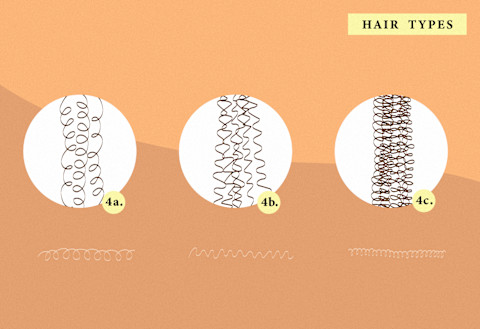Type 4 Hair: Our Full Guide To Caring For Coily Hair (+ Loads Of Expert Tips)

As all curly hair girls know, finding and catering to your curl type is of the utmost importance. The tools, products, and techniques that give you the exact bounce and shape you're looking for will change depending where you fall on the curl spectrum, which can range from type 2 to type 4 (what we'll be discussing here). Additionally, care and styling tips are further influenced by other hair traits such as porosity, thickness, scalp type, and oh how the list goes on.
This is all to say that the unique combinations and varieties that make up your hair play a role in your day-to-day maintenance. And the most important thing you can do for your own special strands is to get to know yourself a bit better. Knowledge is power, after all.
Hair type
A short explainer on hair types, in the event you need a refresher. As we noted, hair is categorized on something of a spectrum—into types from 1 to 4, each with three smaller subsets noted as A, B, or C. Hair types aren't scientific terms (meaning: this isn't a set standard crafted up by researchers in a lab somewhere), but it's pretty universally accepted among hairstylists, trichologists, dermatologists, and even researchers themselves! But we should take a moment and give credit where it's due: It was actually created and made famous by Oprah's hairstylist, Andre Walker.
So as a rundown of the types themselves: Type 1 is straight, with the variance usually coming to how flat your hair lies. Type 2 is wavy, with the major differences depending on how loose the S-pattern is. Type 3 is curly, which changes depending on how tight the curl is. And Type 4 is kinky or coily, which changes depending on whether the shape of the pattern is more zigzag or spring-like.
Finding your hair type
You may already know your hair type pretty well, in which case you can feel free to skip this section. But if you're still sussing out your pattern, we actually have this handy hair type quiz that only takes a few minutes. It asks a variety of questions about your hair's look and behavior, which are all influenced by your specific type.
But ultimately identifying your hair type comes down to visual traits—what you see is what you get. So you need to make sure you're getting the most accurate look at your hair possible. Give yourself the air-dry test: Simply air dry with no added product and see what your hair wants to do naturally.
Additionally, you'll often find that most people have a few patterns to deal with or a patch or two that doesn't seem to fit in with the rest. So you might have to do different techniques for different areas to make it all uniform. (Or embrace the unique textures!) And there are other factors at play: hair porosity, density, and strand thickness. Essentially you've just got to get to know yourself.
Ultimately: "I cannot stress studying your hair enough. A stylist can only give you recommendations, but essentially you go home with your hair," says Danielle Malary, owner of Lumiere Vive Salon. "Feel your hair out, document how it reacts. Essentially, keep a journal for your hair and learn to love it."
For more help identifying your curl type, take mbg's curl type quiz.

Type 4a hair
Type 4, in general, is coiled very tightly. For type 4a specifically, often people describe the ringlets as having the circumference of a crochet needle. Like all type 4 patterns, it is dry and prone to breakage but less so than the others in the group. It's also usually very dense and lush, meaning the strands are tightly packed together.
Styling tips:
- No matter your hair type, we often recommend avoiding sulfates as they are stripping, irritating, and can disrupt your scalp's microbiome. But for curly and coily hair, in particular? A definitive no-go, as it will dry out the already moisture-strapped strands. Check out our favorite sulfate-free shampoos here.
- "Care for your tresses with a once-a-week deep-conditioning mask treatment. This will help restore, renew, and replenish your curls," says hairstylist Miko Branch, co-founder of natural hair care brand Miss Jessie's.
- Avoid excessive heat styling. Everyone is different, so there's no magic number to how often you can feel comfortable doing it, but when you start to see increased shedding, split ends, damage, and loss of curl pattern, we suggest reducing your hot tool usage. "For fragile hair types, daily heat styling is likely to be damaging. Personally, my hair is very naturally dry, so I try to limit the amount of heat styling that I do, too," says board-certified dermatologist Raechele Cochran Gathers, M.D. And when you do heat style, always use a heat protector.
Type 4b hair
Rather than a circular pattern, type 4b looks like Zs. Compare these to a very sharp zigzag pattern—with each change of direction very close to the other.
Styling tips:
- Hair needs hydration, no days off. And to supply your strands with some much-needed drink, we recommend finding a lush yet effortless leave-in conditioner. "The role of these conditioners is to refortify the cuticle with a protective coating and add additional moisture to the cortex, allowing the hair to keep growing without breaking," writes hair expert and author Sarah Roberts. These infuse the cuticle with water, lipids, and (usually) some protective antioxidants. Plus, they usually have some styling properties that can help you revamp your hair when needed.
- Those with coily hair should avoid over-shampooing (yes, even when using sulfate-free options). A good sub-in is co-washing. "Co-washing—or, conditioner washing—allows for gentler cleansing without the drying detergents that can harm the scalp and hair. Also, co-washing protects the integrity and strength of the hair while maintaining its natural oils," says Branch. For more information, check out our co-washing guide.
- Whenever you get your hair wet, seal in moisture with oil or another lipid-based occlusive, such as a butter. The thickness of said product will depend on the hair's porosity (check out the bottom of this article for more information), but in general trapping in that precious hydration will keep your strands healthier.
Type 4c hair
Type 4c will have a very condensed pattern, like 4b, but is closer to spirals, like 4a, than zags. They are also the most fragile of the patterns, prone to breakage, tangling, shrinkage, and may have a harder time encouraging hair growth.
Styling tips:
- This type is the most prone to brittleness, so protection should be top of mind. You can do this by using ultra-hydrating products, being mindful of physical manipulation, and opting for protective styles. "Protective hairstyles are wonderful for minimizing the daily hair routine, covering the ends of hair, and safeguarding natural hair against harsh seasonal elements and damaging environmental factors,” says Branch. "But switch these out every two weeks and give yourself breaks between them," she says to avoid scalp tension, which can lead to traction alopecia, a medical condition in which chronic too-tight hairstyles cause hair loss.
- Since breakage is common, you should encourage healthy hair growth. Pay attention to your diet (which can influence your hair health), give yourself regular scalp massages (which can stimulate blood flow to the area), and use topicals with hair enhancing botanicals (like rosemary and tea). For more hair growth tips, see here.
- When your hair needs hydration, why not pull out all the stops? Don't save deep conditioners for treatments or special occasions—use them in place of a regular conditioner. Masks are inherently more hydrating than regular options, so they'll give you the amped-up benefits you're looking for.
Other hair traits to consider
While hair type influences much of how you treat and care for your hair, it's not the only factor. Other variables play a role in how your hair looks and acts day to day. It's also why those who may have the same hair type will need different routines or styling practices. Hair is so unique, and isn't that just lovely?
Hair porosity
"Hair porosity describes how the hair's cuticle absorbs and holds on to moisture in its pores—hence, the term porosity," says Branch. And it's a spectrum, ranging from high to low. High porosity means the cuticles are more open, so hair absorbs water easily. But it also means it evaporates easily. Hair that has low porosity has dense cuticles. This means the hair has a harder time absorbing water, product, or even your scalp's natural oils, and you'll see buildup faster. It also takes longer to dry after getting wet as it's holding all that water in. Then you can fall somewhere between these two ends of the spectrum, which is considered medium porosity. You can take our hair porosity quiz for more information.
Hair density
Hair density is basically how full your head of hair is. According to celebrity hairstylist Ryan Richman, "The density of the hair is determined by how close your hair strands are to each other. This, in turn, determines how thin or thick your hair appears." Scalps with more hair follicles often appear more lush and full—but may also be drier (especially at the ends) and harder to manage. Scalps with low density may mean wider parts and thinner styles but will usually be shiner and easier to hydrate, says Richman.
Hair thickness
This refers to the diameter of the strand. Thin strands have a small circumference, while thick strands are larger.
The takeaway
Caring for your hair is greatly influenced by your type and subtype. Those with type 4 hair, which tends to be coily and kinky, have endless options to reach their optimal hair health—and it all comes back to how you're hydrating and protecting the strands.
